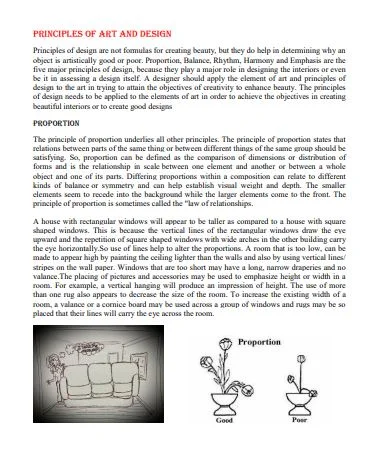‘Principles of Art and Design’ PDF Quick download link is given at the bottom of this article. You can see the PDF demo, size of the PDF, page numbers, and direct download Free PDF of ‘Principles of art’ using the download button.
Principles of Art and Design PDF Free Download

Principles of Art and Design PDF Notes
The principles of art and design are the fundamental concepts that guide artists and designers in creating visually appealing and effective work. These principles help in bringing harmony, balance, and interest to the composition. Here are some key principles:
The principle of proportion underlies all other principles. The principle of proportion states that relations between parts of the same thing or between different things of the same group should be satisfying.
- Balance:
- Symmetry: Creating balance by mirroring elements on either side of a central axis.
- Asymmetry: Achieving balance through the careful arrangement of dissimilar elements.
- Contrast:
- Color Contrast: Using variation in color to create visual interest.
- Value Contrast: Manipulating light and dark areas to emphasize differences.
- Emphasis:
- Focal Point: Drawing attention to a specific area through color, contrast, shape, or placement.
- Isolation: To isolate an element to make it stand out.
- Unity:
- Consistency: Ensuring that all elements work together to form a cohesive and harmonious whole.
- Repetition: Using recurring elements to establish a sense of unity.
- Ratio:
- Scale: Manipulating the size of elements to create a sense of hierarchy or emphasis.
- Golden Ratio: Using mathematical proportions to create aesthetically pleasing compositions.
- Rhythm:
- Repetition: Establishing a visual rhythm through repeated use of elements.
- Flow: Smoothly guiding the viewer’s eyes through the composition.
- Movement:
- Directional Cues: Using visual elements to create a sense of movement and guide the viewer’s eyes.
- Implied Motion: Suggesting movement through stationary elements.
- Harmony:
- Color Harmony: Choosing a harmonious color palette to create a unified visual experience.
- Style Cohesion: Ensuring consistency in the overall style of the composition.
- Pattern:
- Repeating Elements: Creating a regular arrangement of elements to form a pattern.
- Variation: Introducing subtle differences within a pattern for added interest.
- Hierarchy:
- Visual weight: Giving elements importance through size, color or contrast.
- Layering: Arranging elements in a hierarchical order to direct the audience’s attention.
- Economy:
- Simplicity: Removing unnecessary elements to deliver a clear and concise message.
- Minimalism: Achieving maximum impact with the minimum number of elements.
| Language | English |
| No. of Pages | 14 |
| PDF Size | 1 MB |
| Category | Arts |
| Source/Credits | massart.edu |
If you want to download a PPT of this topic click here.
Principles of Art and Design PDF Free Download
